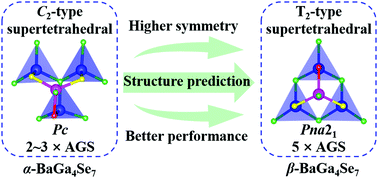β-BaGa4Se7: a promising IR nonlinear optical crystal designed by predictable structural rearrangement†
Abstract
Rationally designing new inorganic materials with specific functional properties is a fascinating challenge. This is particularly true with the nonlinear optical (NLO) crystals, which can expand the spectral ranges of solid-state lasers from ultraviolet (UV) to infrared (IR) through a second harmonic generation (SHG) or optical parametric oscillation (OPO) process. Herein, a high-performance IR NLO crystal, β-BaGa4Se7, has been successfully predicted and synthesized by the optimal rearrangement of the NLO-active basic structure units. The stability and functional properties of the material were simulated by first-principles calculations, and eventually it was also successfully synthesized via a high-temperature solid-state reaction in a sealed silica tube. More importantly, this material can exhibit exceedingly excellent NLO properties, including strong SHG response (5 × AgGaS2), wide transmission range (0.44–20 μm) and high laser damage threshold (680 MW cm−2, 20 × AgGaS2), as well as stable physicochemical properties. These indicate that β-BaGa4Se7 is a promising IR NLO crystal. The discovery of β-BaGa4Se7 can also provide new insights into the rational design of IR NLO crystals based on the predictable structural rearrangement.



 Please wait while we load your content...
Please wait while we load your content...